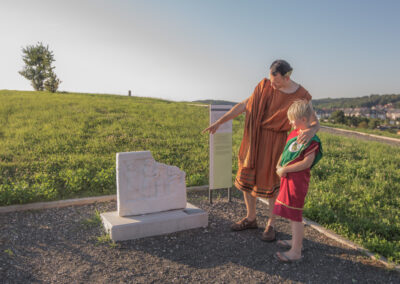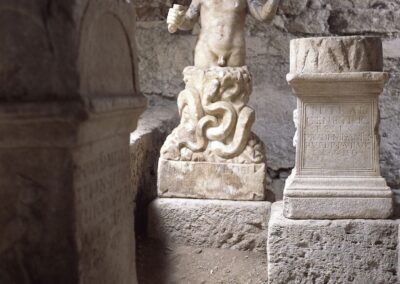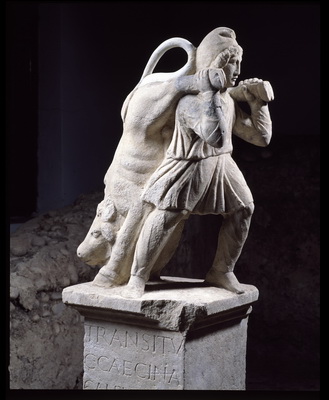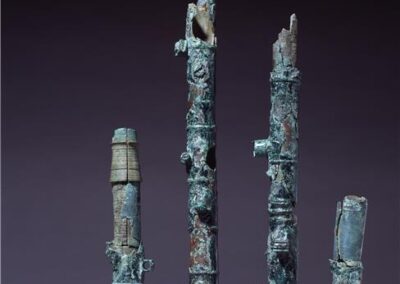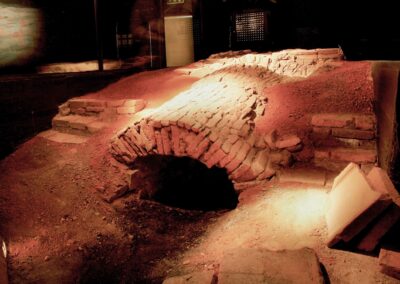
1) Relief dedicated to the Nutrices Augustae
Time in origin: Most likely mid-2nd century
Size: H. 62 cm, w. 71 cm, th. 10 cm, letter h. 2–2.5 cm.
Material: Material/size: Marble.
Find context: Panorama
Description: The depiction shows a woman on the left, possibly a servant, wearing a long dress with short sleeves and holding a basket with goods on her head. The central female figure, in a long dress with short sleeves and hair gathered in a chignon, is holding a naked infant over the altar and handing it over to the Nutrix (head is missing), who is sitting on a throne to the right of the altar and breastfeeding a swaddled infant.
Special: The cult of the Nutrices, in reliefs usually depicted as two or three women, is a rare Celtic element alongside the names of the autochthonous inhabitants of Poetovio that survived into the Roman times. The worship of the Nutrices was very strong here, with the number of dedicatory monuments (as many as 23 recorded monuments with inscriptions and/or relief depictions) even exceeding the dedications to Jupiter or Mithras. It is a local cult only recorded at Poetovio with the exception of a currently lost altar from Maribor.
2) THE ORPHEUS MONUMENT
Time in origin: 2nd century
Size: H 4,94 x W 1,82 x TH 0,39 m
Material: Marble
Find context: Most probably it is located on the site where it was found
Description: In front of the town’s Tower stands the almost 5 m high monument, the biggest ever found in the Roman province of Upper Pannonia. Most probably it is located on the site where it was found. The hardly legible inscription says that the monument, made of marble, was erected in the 2nd century to the then mayor Marcus Valerius Verus. The central relief scene depicts Orpheus who plays his lyre in mourning over the loss of Eurydice, hence its popular name – the Orpheus monument. In the Middle Ages the monument was used as a pillory – »pranger«. Iron rings were attached to the monument’s lower part to tie criminals to it, and by doing so the inscription was damaged.
Special: In the Middle Ages the monument was used as a pillory – »pranger«.
3) THE BIRTH OF MITRA FROM THE ROCK
Time in origin: 2nd half of the 2nd century
Size: H: 0,97, W: 0,46, TH:0,31 m
Material: Marble
Find context: it is located on the site where it was found
Description: Pedestal with a plastic depiction of Mithra’s birth. A snake wraps itself around the rock on the pedestal. A god rises from the rock with a dagger and a torch in his hand. Mithra’s head is not preserved, nor is it the part of the dagger and torch he holds in his hands.
Special: Antique Poetovio used to rank among the biggest centres of Mithraic religion in the Roman Empire. The western area, nowadays known under the name of Spodnja Hajdina, concealed the oldest Mithras Shrine in the Roman Upper-Danube Provinces, which was unearthed in 1898 and 1899. In the middle of the 2nd century AD, it was founded by administrators of the Illyrian customs station based in Poetovio.
The Shrine is kept in situ. It contains several votive stones with inscriptions and reliefs showing myths and attributes related to Mithras, and various stages of worshippers’ spiritual progression. In the central lowered part, a sculpture on the sacrificial altar represents Mithras’ birth from a rock.
4) TRANSITUS
Time in origin: 2nd half of the 2nd century
Size: H: 1,59, W: 0,48, TH: 0,42, letter h.: 0,005-0,003 m
Material: Marble
Find context: it is located on the site where it was found
Description: Carved pedestal with a statue of Mithras carrying a bull.
Special: Antique Poetovio used to rank among the biggest centres of Mithraic religion in the Roman Empire. The western area, nowadays known under the name of Spodnja Hajdina, concealed the oldest Mithras Shrine in the Roman Upper-Danube Provinces, which was unearthed in 1898 and 1899. In the middle of the 2nd century AD, it was founded by administrators of the Illyrian customs station based in Poetovio.
The Shrine is kept in situ. Special attention should be paid to a pillared altar with a sculpture of Mithras known as Taurophorus (Mithras with a bull on his back), which represents one of the only two such monuments still to be found in the world.
5) TIBIA
Time in origin: 2nd – 3rd century
Size: Fragment A – 110.5 mm; | fragment C – 77.4 mm; | fragment D – 102.6 mm; | fragment E – 199.1 mm; | fragment F – 156.9 mm; | fragment G – 100.7 mm;
Material: bone, metal – bronze, metal – copper
Find context: archeological excavations in 1988 in Ptuj
Description: Among the most important exhibits from the rich Ptuj archeological heritage is a rarity of world importance, tibia from the 2nd – 3rd century. The ancient musical instrument, which consists of a pair of flutes, is not completely preserved, but the fragments discovered by archeological excavations in 1988 testify eloquently enough to its original image.
Ovid writes that the tibia sounded in temples and theaters and at mourning ceremonies. Musicians also played it at sacrifices, wedding celebrations, ballroom dancing, wrestling, hunting and whipping slaves, and on other occasions. Tibia was credited with magical powers, and her music was said to chase away evil spirits and summon good.
6) ROMAN BRICKWORKS KILN
Time in origin: 3rd century
Find context: Ιn Ptuj (Rabelčja vas) is displayed on the site
Description: Along the imperial road Aquileia-Savaria in the east part of ancient Poetovio, an important craftsmen’s quarter with large residential buildings, shops, workshops, drying sheds and courtyards was discovered and researched.
The residential buildings of the quarter were embellished with frescoes, stucco and mosaics and heated with hypocausts.
Various workshops were unearthed on the site: those of stone-carvers, smiths, potters, glass-workers, brick-makers and lime-burners. There was a deposit of excellent clay in the vicinity so pottery workshops and brickworks prevailed, and they included kilns, drying sheds, rooms for preparation of clay, and wells.
One brickworks kiln out of numerous that have been discovered in the area, which is today a residential area Rabelčja vas, was displayed on the site. The kiln in which various earthenware products were baked dates from the 3rd century.


